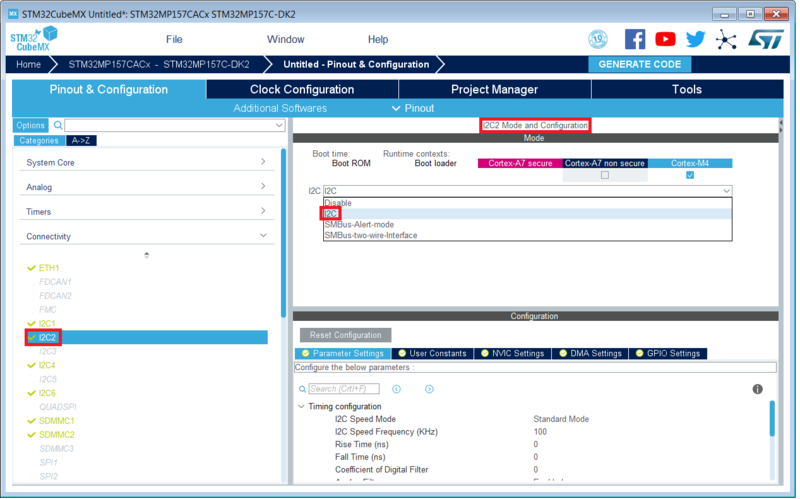1. Article purpose[edit source]
This article explains how to configure the software that assigns a peripheral to a runtime context.
2. Introduction[edit source]
A peripheral can be assigned to a runtime context via the configuration defined in the device tree. The device tree can be either generated by the STM32CubeMX tool or edited manually.
On STM32MP15 line devices, the assignement can be strengthened by a hardware mechanism: the ETZPC internal peripheral, which is configured by the TF-A boot loader. The ETZPC internal peripheral isolates the peripherals for the Cortex-A7 secure or the Cortex-M4 context. The peripherals assigned to the Cortex-A7 non-secure context are visible from any context, without any isolation.
The components running on the platform after TF-A execution (such as U-Boot, Linux, STM32Cube and OP-TEE) must have a configuration that is consistent with the assignment and the isolation configurations.
The following sections describe how to configure TF-A, U-Boot, Linux and STM32Cube accordingly.
3. STM32CubeMX generated assignment[edit source]
The screenshot below shows the STM32CubeMX user interface:
- I2C2 peripheral is selected, on the left
- I2C2 Mode and Configuration panel, on the right, shows that this I2C instance can be assigned to the Cortex-A7 non-secure or the Cortex-M4 (that is selected) runtime context
- I2C mode is enabled in the drop down menu

The GENERATE CODE button, on the top right, produces the following:
- The TF-A device tree with the ETZPC configuration that isolates the I2C2 instance (in the example) for the Cortex-M4 context. This same device tree can be used by OP-TEE, when enabled
- The U-Boot device tree widely inherited from the Linux one, just below
- The Linux kernel device tree with the I2C node disabled for Linux and enabled for the coprocessor
- The STM32Cube project with I2C2 HAL initialization code
The Manual assignment section, just below, illustrates what STM32CubeMX is generating as it follows the same example.
4. Manual assignment[edit source]
This section gives step by step instructions, per software components, to manually perform the peripherals assignments.
It takes the same I2C2 example as the previous section, that showed how to use STM32CubeMX, in order to make the move from one approach to the other easier.
4.1. TF-A[edit source]
The assignment follows the ETZPC device tree configuration, with below possible values:
- DECPROT_S_RW for the Cortex-A7 secure (Secure OS like OP-TEE)
- DECPROT_NS_RW for the Cortex-A7 non-secure (Linux)
- As stated earlier in this article, there is no hardware isolation for the Cortex-A7 non-secure so this value allows accesses from any context
- DECPROT_MCU_ISOLATION for the Cortex-M4 (STM32Cube)
Example:
@etzpc: etzpc@5C007000 { st,decprot = < DECPROT(STM32MP1_ETZPC_I2C2_ID, DECPROT_MCU_ISOLATION, DECPROT_UNLOCK) >; };
4.2. U-boot[edit source]
No specific configuration is needed in U-Boot to configure the access to the peripheral.
4.3. Linux kernel[edit source]
Each assignable peripheral is declared twice in the Linux kernel device tree:
- Once in the soc node from arch/arm/boot/dts/stm32mp151.dtsi , corresponding to Linux assigned peripherals
- Example: i2c2
- Once in the m4_rproc node from arch/arm/boot/dts/stm32mp157-m4-srm.dtsi , corresponding to the Cortex-M4 context. Those nodes are disabled, by default.
- Example: m4_i2c2
In the board device tree file (*.dts), each assignable peripheral has to be enabled only for the context to which it is assigned, in line with TF-A configuration.
As a consequence, a peripheral assigned to the Cortex-A7 secure has both nodes disabled in the Linux device tree.
Example:
&i2c2 { status = "disabled"; }; ... &m4_i2c2 { status = "okay"; };
4.4. STM32Cube[edit source]
There is no configuration to do on STM32Cube side regarding the assignment and isolation. Nevertheless, the resource manager utility, relying on ETZPC configuration, can be used to check that the corresponding peripheral is well assigned to the Cortex-M4 before using it.
Example:
int main(void) { ... /* Initialize I2C2------------------------------------------------------ */ /* Ask the resource manager for the I2C2 resource */ ResMgr_Init(NULL, NULL); if (ResMgr_Request(RESMGR_ID_I2C2, RESMGR_FLAGS_ACCESS_NORMAL | \ RESMGR_FLAGS_CPU1, 0, NULL) != RESMGR_OK) { Error_Handler(); } ... if (HAL_I2C_Init(&I2C2) != HAL_OK) { Error_Handler(); } }
4.5. OP-TEE[edit source]
The OP-TEE OS may use STM32MP1 resources. OP-TEE STM32MP1 drivers register the device driver they intend to used in a secure context. This information is used to consolidate system configuration including secure hardening of configurable peripherals.
In most case, the OP-TEE driver probe relies on OP-TEE device tree porperty secure-status = "okay".